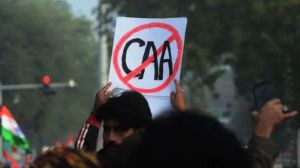Water on tap,24×7? Possible
The current water shortage in most cities is not due to inadequate supplies but lax management.
The current water shortage in most cities is not due to inadequate supplies but lax management. Several examples from the developing world show that better governance can ensure uninterrupted delivery
Scorching heat and no water is the reality for much of India during the summer months. The national Capital Delhi runs short by 1,100 million litres of water per day during peak summer implying that each resident gets 70 litres less water per day.
The story is far worse in neighbouring Gurgaon,the Millennium City that is host to numerous multinationals. Gurgaon boasts eight golf courses,which together consume 120 million litres of water daily a quantity that can meet the daily water requirements of about a million people. Where does this water come from? Groundwater a resource that has been indiscriminately exploited not only in Gurgaon,but throughout the country.
Dire Straits
Groundwater is the main source of water for households,industries,golf courses and water theme parks. Private bore wells run as deep as 160 feet and the water table is declining at an alarming rate of 6 feet per year. Scientists believe that at this rate there will be no ground water left for Gurgaon after 2017,just five years away.
The situation is no better in other cities. There is no city in India that can claim to provide adequate water to its citizens. Although cities such as Nagpur,Amravati,Latur in Maharashtra and Hubli-Dharwad in Karnataka have recently piloted 24×7 piped water supply,they are yet to reach the necessary scale and most cities still supply water only for few hours a day.
On an average,Indore supplies water for only 45 minutes per day,Ahmedabad for two hours,Delhi four hours. Chandigarh scores much better at 12 hours of supply per day.
The current approach to address water shortages has always focused on supply augmentation as the solution and that has been the primary fallacy of most policy responses.
The problem is definitely not on the quantity side. The average per capita supply of water in Delhi is 220 litres per day and Mumbai 240 litres per day. Most cities such as Hyderabad,Surat,Ajmer,Nagpur,Vijaywada,have an average supply of water of more than 120 litres per day but no city can claim to supply water for more than few hours in a day.
Internationally,cities such as Kuala Lumpur or Colombo,with similar levels of water supply per capita provide water 24×7. Cities in the developing world such as Jakarta and Dakar,with per capita production of less than 100 litres per day also supply 24×7.
The usual response from politicians and water administrators for the appalling water situation is inadequate bulk supply,lack of finance with municipalities or water utilities to undertake major projects,lack of staff and irresponsible water consumption practices.
The Ministry of Urban Development collected service level benchmarking data for 28 cities and found that 44 per cent of water is unaccounted lost in transmission or stolen. Only half of the water connections are metered. There are on average 8 staff per 1,000 connections or 125 connections per staff member,while other countries make do with half that number.
A number of water utilities in cities across Africa,Asia,and Latin America have successfully transformed themselves into service oriented utilities. The current state of water utilities in India is no different from the state that these transformed water utilities were prior to their transformation. The magic potion has not been more water but an improved water governance and management.
Governance
Efficient governance requires strong leadership that can put together enabling policies and regulation,allocate necessary financial resources and provide incentives for increased investment.
In Phnom Penh,Cambodia,the water utility was led by a very competent leader and during its transformation was protected from political interference in the delivery of services and collection of water charges by no less than the countrys prime minister.
Water and sanitation measures in Singapore were coordinated at the level of the prime ministers office,which accorded water top priority. The Metropolitan Waterworks Authority (MWA) in Bangkok was transformed from a typical government entity to a business oriented utility by the then head of MWA who introduced necessary changes and obtained support from the government for projects,activities,and management measures,such as upward revision of tariffs.
Efficient delivery of water services is possible if all activities associated with water are under the management of one authority. The Public Utilities Board of Singapore manages water supply,water catchment,and sewerage in an integrated manner and so did Shenzen in China.
In India too,we have examples where efficient leadership has driven large projects the Alandur underground sewerage project in Chennai was built under the leadership of the then mayor,RS Bharathi. The Nagpur 24×7 water pilot project is also an outcome of joint efforts by local politicians and officials.
Autonomy for a water utility from political interference and operational arrangements like a business entity (comprising transparent management,reward for employees to perform,and internal control systems in the form of audits),is a necessary element that transformed water utilities embraced to deliver better public services.
MWA,Bangkok is operated and managed like a business entity which focuses on work efficiency and pays bonuses to employees for better performance. It has instituted internal control systems that help employees,units,and offices to perform in accordance with regulations,operational evaluations,and financial and accounting audits. Transparency and accountability are key requirements for transforming utilities.
Given that the demand for water is increasing in most cities and supply side solutions are increasingly becoming expensive,a diversified solution to augment supply will be required. Singapore has diversified its water supply to include recycled and desalinated water. Though recycled water has immense potential in India,negative public perception has been a major hurdle in its acceptability. In Singapore,the lower cost of recycled water,called NEWater and its purity has slowly found acceptability among customers. This has happened over time due to a focused awareness campaign.
Operations
One of the important components of sound financial management is undertaking measures that reduce non-revenue water (NRW). The first step is installing an accurate water metering system at the household level. Phnom Penh increased its metered connection coverage from 12.6 per cent in 1993 to 100 per cent in 2001. The Manila Water Company has developed a decentralised system based on a district metering area for detecting problems like water leakages,pipe bursts,and faulty metering. The company has partnered with community organisations,which inform it on leakages and other problems. Phnom Penh introduced a system based on peer monitoring to detect illegal connections. If a meter reader did not find an illegal connection but her colleague did,the meter reader was penalised while the colleague was rewarded.
When affordability levels and the willingness to pay are low,a mix of options would be needed rather than aiming towards achieving full cost recovery for supplies.
These options could include grants,user charges,cross-subsidies,and taxes. Phnom Penh presents an interesting case in tariff rationalisation where it revised tariffs gradually over seven years. This was done by improving services first,and then proposing the revision in tariffs. Once customers saw improved delivery,the willingness to pay increased.
Successful utilities have been able to improve the productivity of their staff enormously. For example,the number of staff members per 1,000 connections in Phnom Penh in 1999 was about 8,which came down to 3.3 in 2008. It did not stop there. The utility invested in capacity building,compensated adequately and was tough on corrupt practices.
Solutions for water shortages are often not in inadequacy of quantity but in sound governance and operations and this is the lesson that our politicians and administrators of water utilities have to imbibe.
The author is Associate Professor of Property,University of Melbourne,Australia and Partner,Indu Consultants (ICON) India



- 01
- 02
- 03
- 04
- 05




























